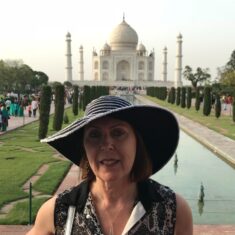Experiencing Tibet
“I’ve recently returned from a wonderful trip to Tibet, organized by Ventours. What a privilege to be able to travel to this off-the-beaten-path destination, a place that is changing by the day, and to spend time in my beloved Nepal, next door. There was magic in the air and the opportunity to completely disengage oneself from the outside world.
Removed from our bubble of comfort, we can start to truly see and understand that, though the miles between us might be vast, the importance of age-old traditions and culture remains. When we share these with each other, before they’re lost to the sands of time, our world becomes ever brighter.
If, however, you are intrigued by a very real adventure, a thorough and immersive visit, and are aware of, and understanding of, the complications that may come up during your travels, then my advice is: Go now. Based on my recent trip, I feel that the Chinese influence is diluting the true Tibetan experience, a realization that stirred up an array of emotions during our travels in the region. In the end, I felt incredibly fortunate to have been there to experience a place that is changing so rapidly … changing, yes, but also changing the way we see the world.
So, yes, if you are culturally curious and sympathetic, well-traveled, active, open to unpredictability and don’t need the bells and whistles of luxury travel to call it a successful trip, then this is the right time and the right trip. In particular, if you have perhaps already been to Nepal, India and parts of China, and realize just how special a Tibetan adventure is at this moment, then yes, do it now before change makes it unrecognizable.
I would suggest a week, with some well-earned creature comforts built in at beginning and end, to take full advantage of the countryside.
Here are some of the highlights from our trip which began in Lhasa– it really was such a dreamy, inspiring and humbling journey.
You’ll forgive me for being unable to sufficiently impart just how incredible Lhasa’s Potala Palace is – a “wow” moment, to be sure. One can’t escape the views of this renowned and towering structure, easily glimpsed from practically anywhere in the city. To think, it was built in the 17th century … so high, so ornate, so vast, the Potala Palace was once home to the Dalai Lama,and is a truly unforgettable experience.
Throughout the day, and also during a very special evening visit, we were able to visit 20 of the 1,000 rooms, as well as dozens of chapels, golden stupas and prayer halls. For many visiting Tibet, the experience of seeing the iconic palace may be enough – it was certainly a stirring experience for all of us on the trip and spurred our enthusiasm for what was to come.
Then we were on to Norbulingka for an emotional visit to the New Summer Palace, built by the present (14th) Dalai Lama between 1954 and 1956. Among the highlights: the Dalai Lama’s audience chamber and its mythical murals depicting the history of Tibet, including the birth of its people and construction of its greatest monasteries. We were able to tour the Dalai Lama’s private quarters and meditation chamber, as well as the assembly hall and its gold throne.
A comprehensive Lhasa visit must include both the Drepung Monastery and Johkang Temple – and another full day took us to both, plus included time for strolling through Barkhor. Drepung, at the foot of Mount Gephel, is recognized as one of the three great Gelug university gompas, or monasteries, of Tibet. Early in the 20th century, there could be as many as 10,000 monks practicing here, yet since the 1950s, Drepung, as well as Ganden and Sera, watched their independence and spiritual credibility slide as Chinese security increased. These three monasteries were reestablished in south India, in exile, in the 1950s.
From Lhasa we began a journey to Shigatse that took us through Gyantse, known as the Hero City, since the Tibetans resisted Francis Younghusband’s British Expedition to Tibet in 1904.
It’s no secret that mountains, lakes and land as far as one can see feed my soul and so, you can imagine my delight at our first view of the striking, jewel-colored Yamdrok Lake, one of the Gyanste region’s three sacred lakes.
The clouds parted for a seemingly celestial-inspired vista of the turquoise lake … it was like a dream. We must have experienced four seasons that day, the weather always changing, and yet, when the mists parted, the dramatic views were almost more inspiring than if we had had constant bluebird skies.
This long day’s journey, over the very high-altitude Gampal and Karola passes, 16,075 and 16,732 feet, respectively, took patience, to be sure, but it gave us the opportunity to enjoy some peaceful moments, listening to music and taking in the remote countryside through which we were passing, yaks wandering nearby, and mountains surrounding us that most only dream of seeing.
Our fortune ran deep, as less than two hours later, we found ourselves under sunny skies at Everest Base Camp. Since one can’t drive to EBC from within Nepal, it was quite special to have it so accessible to us.
Again, the brilliantly sunny skies we experienced is not always the weather one can expect — one could drive all that way and find Everest completely socked in by clouds and fog, but we were fortunate.
From Shigatse, we opted for the two-hour train ride back to Lhasa – much quicker and more comfortable than the road journey. My suggestion would be to drive one way, so as to see the countryside and experience the monasteries, and treat yourself to the train in the other direction.



